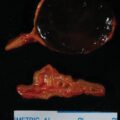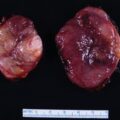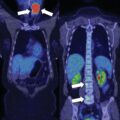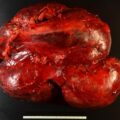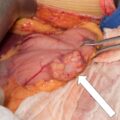Catecholamine-secreting tumors (pheochromocytoma and paraganglioma [PPGL]) can be found in the midline from the inner ear to the scrotum. However, most (≈85%) are located in the adrenal glands and 95% are between the diaphragm and pubis. Cardiac PGL is an unusual and challenging location. Such a case is reported herein.
Case Report
The patient was a 43-year-old woman who had been diagnosed with multiple PGLs 13 years before the current consultation. However, she previously declined surgical intervention because of the operative risks. She went on to have three pregnancies; two were successful live births, and cesarean deliveries were performed as the result of marked hypertension in the third trimester. Her hypertension was poorly controlled on a calcium channel blocker (amlodipine 5 mg daily) and a combined β- and α-adrenergic blocker (labetalol 400 mg twice daily). She also had insulin-requiring type 2 diabetes mellitus under poor glycemic control. On physical examination her body mass index was 24.5 kg/m 2 , blood pressure 124/81 mmHg, and heart rate 75 beats per minute. The patient was not in respiratory distress, and examination of her heart and lungs was normal. She wanted to reconsider surgical management of her PGLs.
INVESTIGATIONS
The plasma fractionated metanephrines and 24-hour urine for fractionated metanephrines and catecholamines unequivocally confirmed the diagnosis of catecholamine-secreting PPGL ( Table 45.1 ). Chest magnetic resonance imaging (MRI) showed a 6.8 × 4.3–cm hypervascular pericardial PGL in the right atrioventricular groove that encased 50% of the ascending aorta and also encased the origin of the right coronary artery ( Fig. 45.1 ). Abdominal computed tomography (CT) angiography showed a 4.7 × 3.3–cm organ of Zuckerkandl PGL and a 1.9-cm urinary bladder PGL ( Fig. 45.2 ). F-18 fluorodeoxyglucose positron emission tomography CT showed the three known PGLs and no evidence of additional paragangliomas or metastatic disease ( Fig. 45.3 ). The patient proved to have a large gene deletion in succinate dehydrogenase subunit B (deletion of exons 3–8).
| Biochemical Test | Result | Reference Range |
| Sodium, mmol/L | 140 | 135–145 |
Potassium, mmol/L | 5.3 | 3.6–5.2 |
Creatinine, mg/dL | 0.61 | 0.6–1.04 |
Glycosylated hemoglobin, % | 9.4 | 4.2–5.6 |
Plasma metanephrine, nmol/L | 0.21 | <0.5 |
Plasma normetanephrine, nmol/L | 28.0 | <0.9 |
24-Hour urine: | ||
Metanephrine, mcg | 230 | <400 |
Normetanephrine, mcg | 9859 | <900 |
Norepinephrine, mcg | 2744 | <80 |
Epinephrine, mcg | 8.2 | <20 |
Dopamine, mcg | 1036 | <400 |
Stay updated, free articles. Join our Telegram channel

Full access? Get Clinical Tree



